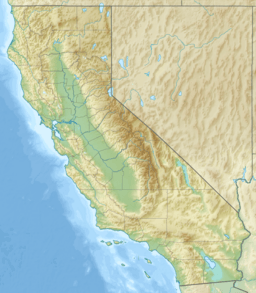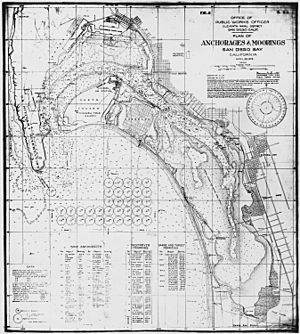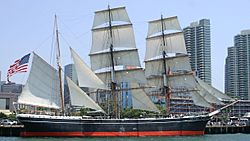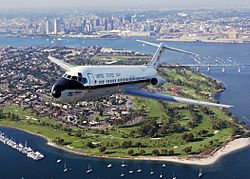San Diego Bay facts for kids
Quick facts for kids San Diego Bay |
|
|---|---|
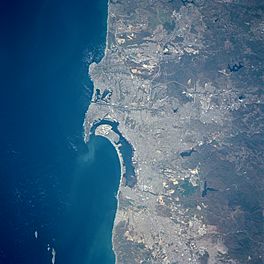
San Diego Bay from Space
|
|
| Location | San Diego County, California |
| Coordinates | 32°39′N 117°11′W / 32.65°N 117.19°W |
| River sources | Otay and Sweetwater Rivers; Paradise Creek |
| Ocean/sea sources | Pacific |
| Basin countries | United States |
| Max. length | 12 miles (19 km) |
| Max. width | 3 miles (5 km) |
| Surface area | 19 square miles (49 km2); 12,000 acres |
| Average depth | 21.33 feet (6.50 m) |
| Max. depth | 60 feet (18 m) (dredged) |
| Settlements | San Diego, Coronado, Chula Vista, Imperial Beach, National City |
San Diego Bay is a large, natural harbor and deepwater port in San Diego County, California. It's located very close to the U.S.–Mexico border. The bay is about 12 miles (19 km) long and 1 to 3 miles (1.6 to 4.8 km) wide. It's the third largest natural bay on California's long coastline, after San Francisco Bay and Humboldt Bay.
Many cities are located around the bay, including San Diego, which is one of the largest cities in the United States. Other cities like National City, Chula Vista, Imperial Beach, and Coronado also border the bay.
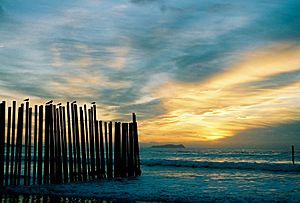
San Diego Bay is known as one of the best natural harbors on the west coast of North America. It was first settled by Spain in 1769. For many years, it was a major base for ships of the United States Navy in the Pacific Ocean. Before World War II, the main base for the United States Pacific Fleet moved to Pearl Harbor, Hawaii. However, San Diego Bay is still a very important home for many U.S. Navy ships, including several aircraft carriers. It has some of the biggest naval facilities still operating in California.
Contents
Shipping and Cruise Ports
The Port of San Diego is a busy place! It has special areas for large container ships, including one for refrigerated goods. There are also terminals for cruise ships. A second cruise ship terminal opened in 2010. The port handles over 3 million metric tons of cargo every year.
At its busiest in 2008, the cruise ship terminal welcomed more than 250 ships and over 800,000 passengers. However, the number of cruise ship visits has decreased since then.
General Dynamics' National Steel and Shipbuilding Company (NASSCO) is located near the San Diego side of the San Diego-Coronado Bay Bridge. This is the only shipyard on the west coast that can build and fix very large ocean-going ships. San Diego International Airport is also right next to the bay.
San Diego–Coronado Bridge
The San Diego–Coronado Bridge crosses the bay. It was built in 1969. The bridge has a unique curve and rises to 200 feet (61 meters) above the water. This height allows most Navy ships to pass underneath it. However, very large ships like the Nimitz class aircraft carriers are too tall. That's why these huge carriers are docked north of the bridge.
The bridge used to have a toll, meaning you had to pay to cross it. But in 2002, the toll collection stopped because the loans for building the bridge were fully paid off.
America's Cup Harbor
This small area in the bay used to be called Commercial Basin. It was home to many fishing boats. In 1994, it was renamed America's Cup Harbor. This was to honor the 1995 America's Cup sailing races, which were held in San Diego. America's Cup Harbor now has several boat repair yards and marinas for private sailing yachts. It also has a special area where boats can anchor.
Fun Things to Do at the Bay
San Diego Bay is a popular spot for fun and relaxation! Many resorts, hotels, and the San Diego Convention Center are located right next to the bay. There are also several parks and nature areas along the shoreline.
You can take sightseeing boat tours that leave from the downtown area. If you like fishing or want to see whales, commercial sport fishing and whale watching tours depart from Shelter Island.
Ten museum ships are docked in San Diego Bay. One of the most famous is the USS Midway, which is an aircraft carrier that is now a museum. Another amazing ship is the Star of India. It's the oldest iron-hulled merchant ship that can still float and the world's oldest active sailing ship! The Star of India and eight other ships are part of the San Diego Maritime Museum. You can visit them for a fee, and many of them are still able to sail.
In the northern part of the bay, there are two "islands" called Harbor Island and Shelter Island. They are actually peninsulas connected to the mainland by a narrow strip of land. These areas now have hotels, restaurants, marinas, and public parks.
Across from Harbor Island is a park called Spanish Landing. This is a historic spot that remembers when two expeditions from Spanish Mexico met here in 1769. This meeting helped start the European settlement of California. At Spanish Landing park, the San Diego Maritime Museum is building a full-sized, working wooden copy of the San Salvador flagship. This was the ship that explorer Juan Rodriguez Cabrillo used when he discovered San Diego Bay in 1542.
Sailing small boats is very popular here. The bay has many marinas and nine yacht clubs, including the San Diego Yacht Club. This club was home to the America's Cup sailing race from 1988 to 1995. For both visitors and locals, many businesses offer jet ski rental and boat rental so you can explore the beautiful water.
Special Events at the Bay
Every year on the Fourth of July, there's a huge fireworks show called the Big Bay Boom. Fireworks are launched at the same time from four barges in the bay and from a pier in Imperial Beach. It's one of the biggest fireworks displays in the United States, and about half a million people watch it every year!
The Parade of Lights is a fun event held on two Sundays in December. More than 80 small boats decorated with holiday lights parade through the bay. This parade has been happening every year since 1972. It starts near Shelter Island and goes past Harbor Island and Downtown, ending at the Coronado ferry landing.
In February 2011, there was a special "Parade of Flight" to celebrate 100 years of naval aviation. Over 200 historic naval aircraft flew over San Diego Bay. The event ended with a flyover by the air wing from the U.S.S. John C. Stennis.
A long, narrow strip of land called the Silver Strand protects the western side of the bay from the Pacific Ocean. The northern end of the Silver Strand widens into North Island. This is where Naval Air Station North Island is located, which is home to several aircraft carriers, including the USS Theodore Roosevelt. Coronado is also on North Island and is home to the famous Hotel del Coronado.
The U.S. Navy has three other important facilities on the bay: Naval Station San Diego, Naval Base Point Loma at Ballast Point (which is a base for nuclear Submarines), and Naval Amphibious Base Coronado. The Coast Guard Air Station San Diego is across the bay from NAS North Island. The U.S. Marine Corps also has one of its two Recruit Depots near the shores of San Diego Bay.
Bay Ecology and Wildlife
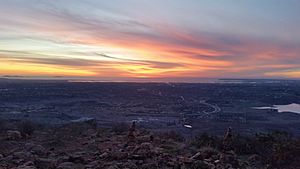
The shallow southern part of the bay is used to get salt from seawater using evaporation ponds. These salt ponds, along with the Sweetwater Marsh and other areas, are part of the San Diego National Wildlife Refuge Complex. This area has the largest continuous mud-flat in Southern California.
It's a very important stop for migrating birds on the Pacific Flyway. Many endangered and threatened plants and animals live here. You can visit the Chula Vista Nature Center, which has walking trails and exhibits about the bay's natural resources.
San Diego Bay is protected by the California Bays and Estuaries Policy. Long ago, even whales were seen in the bay during winter!
Keeping the Bay Clean
Sometimes, pollution can enter the bay from things like storm-water runoff and waste from ships. The city of San Diego has worked hard and spent a lot of money to clean up this pollution, especially in areas like the Shipyards Sediment Site. Efforts are ongoing to make sure the bay stays healthy for everyone.
The California Office of Environmental Health Hazard Assessment (OEHHA) gives advice on eating fish caught in the Salton Sea. This advice is based on levels of mercury or PCBs found in local fish.
How the Bay is Managed
The Port of San Diego is in charge of managing the harbor and the public lands next to the bay. The Port is a special government group created in 1962. It gets its money from fees and rents paid by businesses that use the port.
San Diego Bay and the U.S.-Mexico Border
San Diego Bay is mentioned in the Treaty of Guadalupe Hidalgo. This treaty helped decide the Mexico–United States border after the Mexican–American War. The border is defined as being "one marine league" (about 3.45 miles or 5.56 km) "due south of the southernmost point" of the bay.
Images for kids
-
San Diego Bay & Coronado Islands at sunset.
See also
 In Spanish: Bahía de San Diego para niños
In Spanish: Bahía de San Diego para niños


